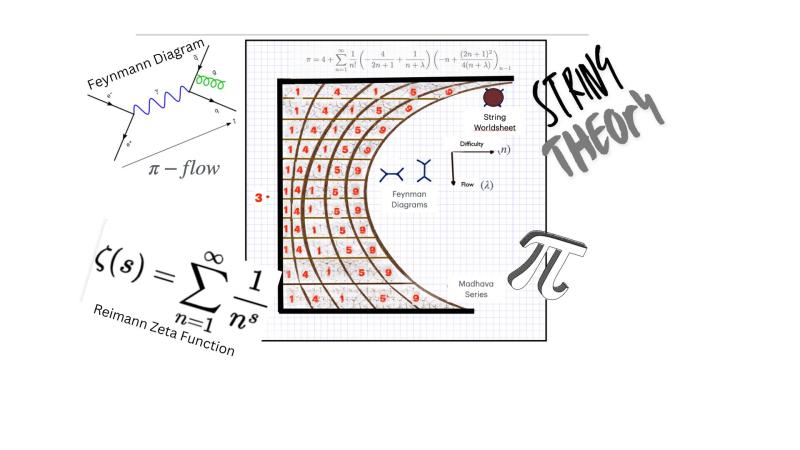
If maths is the language the universe was written in, then pi, written as π, is surely one of its favourite characters. Initially discovered as a mathematical constant of the ratio between the circumference and radius of a circle, we soon realised that the number pops up everywhere when we study the properties of the universe and its constituents. From thermodynamics and electromagnetism to biological sciences and creation of our entire digital ecosystem, the humble pi makes its appearance. The number has gained such a cult following that we even have a day to celebrate it - pi day, celebrated on the 14th of March, because of its resemblance to the first 3 digits (3.14).
Pi is an irrational number, meaning it cannot be written as the ratio of two real numbers and the digits after the decimal continues to infinity. In order to find the digits of pi after the decimal, mathematicians use what is called a series representation - adding infinitely many digits.
“The oldest series representation of pi was given to us by the famous Indian mathematician, Madhava in the 14th century, before the invention of calculus. Later refinements were attempted by many luminaries, including Newton, who found different series using calculus and spent leisure hours calculating up to 15 decimal places of pi” remarks Prof. Aninda Sinha, a professor at the Center for High Energy Physics at Indian Institute of Science (IISc).
However, using even the most modern series representation, calculating the digits of pi can be an arduous task, and involves summing billions of digits.
Pi belongs to a class of numbers called transcendental numbers. These are non-algebraic numbers, meaning they cannot be written in the form of an algebraic equation with rational coefficients.
“Like pi, there are other similar transcendental numbers like the Zeta function, which makes an appearance in the famous unsolved Riemann hypothesis. This function was invented by the Swiss genius, Leonhard Euler in the 18th century. Euler also invented a quantity called the Beta function, which made an unusual appearance in physics in the 1970s. In addition, the pi and Zeta function appear as specific limits of this famous function” says Prof. Sinha.
The Euler-Beta function usually illustrated in theoretical physics provides the backbone for explaining phenomena such as high-energy particle collisions. In high-energy experiments, like the Large Hadron Collider (LHC) in CERN, Switzerland, particles, like protons or electrons, are accelerated to speeds close to the speed of light and then collide. Similar to smashing an object to break it open and reveal its constituents, colliding particles at such high energies allows for the production of virtual particles to be created, thus probing the constituent particles of the Universe. Such experiments can be termed as scattering experiments. Light scattering from objects allows us to see an object. Similarly, particles scattering from high-energy collisions allows us to see the constituents of the particles. The more energy we put into the scattering experiments, higher the resolving power of the experiment, revealing higher- mass virtual particles.
“In principle, there is nothing that prevents us from going to higher and higher energies, where we would see a plethora of higher mass particles. The Euler-Beta function gave us the answer for such an experiment which would show up an infinite number of higher mass particles—it eventually was reinterpreted as a theory of Strings.” explains Prof. Sinha.
Using this principle of String theory, each term in the infinite series representation of transcendental numbers can be interpreted as arising due to the specific exchange of a virtual particle.
In a new study published in Physical Review Letters, Prof. Sinha, Arnab Priya Saha, an inspire faculty postdoctoral researcher at IISc, have proposed using this String theory interpretation of the series representation of transcendental numbers, to minimise the infinite series calculations. The study proposes using a particular interpretation of quantum particles called Quantum Field Theory (QFT). QFT assumes that every particle that we measure is arising due to an associated field. Photons are the quantum of electromagnetic fields, electrons are produced from an electron field, and the infamous Higgs boson is produced by a Higgs field. Such an interpretation allows physicists to calculate the probability of scattering in high-energy scattering experiments, without having to go through millions of calculations and possible answers for the Euler-Beta function. Moreover, the interpretation has no effect on the final answer obtained since it does not affect the physics of the particles. The new study proposes that the same technique can be used to find solutions for the Euler-Beta function, and by extension to pi and Zeta functions.
“By considering string theory as an interacting quantum field theory of such particles, we can derive new formulas that not only extrapolate to the Madhava series for pi and the series representations of Euler's Zeta functions, but also converge faster than their original counterparts.This work for the first time in the 300-year history of the Euler-Beta function finds such a parametric representation for this function and hence the associated pi and Zeta functions using physics considerations” explains Prof. Sinha.
This work builds on an earlier study by Prof. Sinha, where a ‘Bootstrap approach’ of QFT was used to explain Feynman Diagrams, a graphical representation of particle interactions.
Talking about the importance of mathematics in advancing physics, Prof. Apporva Khare, Associate Professor in mathematics at IISc says “Professor Sinha's joint paper reinforces how disparate fields of research - in this case, mathematics and physics - have contributed to each other. This has been a recurrent theme in the development of both sciences. For instance, Newton developed calculus in order to apply it to physics questions including gravitation. Einstein's acclaimed theory of General Relativity uses Riemannian geometry and tensor calculus, tools developed earlier by mathematicians.”
Only this time around, it is ideas from physics that could contribute to advancing mathematics.
The new study allows us to probe the universe at energy levels which cannot be physically attained with current technologies. It can help predict the outcome of high-energy collisions, much higher than what even the LHC can achieve. The authors believe the study could also potentially present long-sought connections between string theory and experimental observations. Although string theory was originally conceived in the 1960s, it has largely remained confined to a theoretical proposition, with no way to test the theoretical concepts. A connection to experimental observations could finally tell if and what aspects of the theory can be pursued further. More importantly however, the study presents a way to inspect some long standing problems in mathematics, like the Reimann hypothesis from a new lens. It also reinforces the idea of cross-pollination of ideas from multiple disciplines for the advancement of our knowledge of the universe.
“The paper by Sinha and Saha has now provided - in addition to new insights in physics - novel ideas in mathematics. Notable among these are fast converging formulas for pi and for Riemann zeta function values. Thus, the paper will hopefully lead to a better understanding of these special values in number theory, underscoring yet again the importance of cross-disciplinary studies and how they end up enriching both disciplines.” concludes Prof. Khare.






